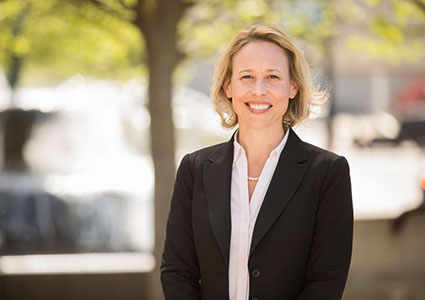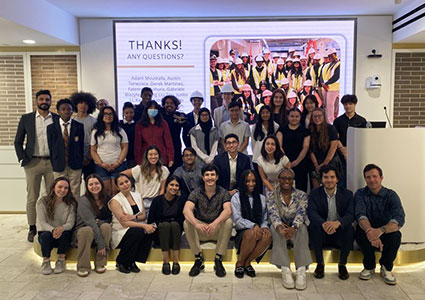Lisa Woodruff of Turner & Townsend discusses transforming performance for a green, inclusive and productive world
My background is in architecture, and I’ve worked in the construction industry for nearly 30 years, in various roles from architect to project and program manager,” begins Lisa Woodruff, Executive Vice President and North America Head of Real Estate at Turner & Townsend. “I had my own business for many years providing design and project and program management for clients. I think this experience gives me a unique perspective, both from the client side and from an industry viewpoint.
“I’ve been with Turner & Townsend for 13 years now. My specialty is in retail but over the years, I’ve worked within multiple sectors. My experience has been a blend of client facing and business operation roles. I started off managing an electric vehicle charging program for Nissan, one of our key clients. From there, as we grew our Nashville office, where I’m based, I went into a role leading our Nashville business operations. I took on a few more hats, leading our retail sector nationally and then globally, which I still do today. I have also looked after several key accounts in my time in the business. A few years ago, we restructured a little in line with growth, separating the east and west of our US territories. I look after our eastern operation, and this year I also took on the real estate lead role.
blend of client facing and business operation roles. I started off managing an electric vehicle charging program for Nissan, one of our key clients. From there, as we grew our Nashville office, where I’m based, I went into a role leading our Nashville business operations. I took on a few more hats, leading our retail sector nationally and then globally, which I still do today. I have also looked after several key accounts in my time in the business. A few years ago, we restructured a little in line with growth, separating the east and west of our US territories. I look after our eastern operation, and this year I also took on the real estate lead role.
“From a business perspective, it’s been an interesting journey and I’ve been blessed to be a part of this amazing growing organization. I’ve also held a few specialty roles over the years, such as our corporate responsibility board sponsor. I’ve been in that role for a few years and that ties back to my passion for giving back to communities and mentoring the next generation. There are a few different boards I’m involved in locally and nationally. Matthew 25 is a local non-profit organization for homeless veterans, and ACE Mentoring is an organization across the US that helps young people throughout high school and into their college education,” she explains.
Industry insight
Turner & Townsend is a global professional services company with more than 12,000 people operating in 49 countries. The company provides clients with a premier program project and cost management offering. “Our purpose,” Lisa continues, “is all about making a difference, and transforming performance for a green, inclusive and productive world. We’ve had a strategic partnership with CBRE Group since 2021 and we recently announced a plan to combine CBRE’s global project management arm with Turner & Townsend. Personally, in terms of leading our North America real estate business, this is an opportunity to make a difference for our people, our clients, and the industry. We’re focused on driving high performance across our business operations and our service delivery, bringing our global best practices to our local teams to help our clients improve performance. This is particularly relevant for large-scale complex programs and projects, such as BlueOval City which is a planned automotive assembly complex near Stanton, Tennessee that will be operated by Ford Motor Company and SK Innovation.
“Alongside this fundamental aspect of my role, I would say I’m able to blend my passion for communities, and for getting involved with projects and programs. The YMCA of Middle Tennessee for example, which provides a unique community resource, supporting residents’ wellbeing through healthy living, youth development and social responsibility initiatives, is our largest pro bono project ever undertaken in North America. Additionally, the opportunity to engage with our teams and help develop talent and future leaders is an aspect of my role I particularly enjoy.”
Each year Turner & Townsend produces its International Construction Market Survey report, which provides data from 91 global markets about construction costs and trends. “Our clients love this report,” Lisa elaborates. “It provides trend-driven research, up-to-date data and complements some of the other information we give to our clients. From the recent report, I found some of the key findings interesting and some not surprising. Six of the world’s top ten most expensive cities are here in the US, which reflects strong economic recovery and demand, particularly for advanced manufacturing and data center construction.
 “New York being the world’s most expensive city; there’s maybe no surprise there, but with an average cost of $5723 per square meter, it is up five percent compared with 2023. Cost escalation in the city is being partly driven by buoyed demand in residential and commercial property; the cost of a high-rise, premium office block has reached an average of $10,660 per square meter. San Francisco follows closely behind at $5489 per square meter, and Los Angeles, Boston, Seattle and Chicago also feature in the top ten. That strong construction activity in the market has led to the stretched labor supply and cost escalation which is predicted to average a little over four percent this year. This makes our role even more important. We’ve got to help our clients navigate those challenges, by enhancing efficiencies, reducing costs, and finding innovative solutions.
“New York being the world’s most expensive city; there’s maybe no surprise there, but with an average cost of $5723 per square meter, it is up five percent compared with 2023. Cost escalation in the city is being partly driven by buoyed demand in residential and commercial property; the cost of a high-rise, premium office block has reached an average of $10,660 per square meter. San Francisco follows closely behind at $5489 per square meter, and Los Angeles, Boston, Seattle and Chicago also feature in the top ten. That strong construction activity in the market has led to the stretched labor supply and cost escalation which is predicted to average a little over four percent this year. This makes our role even more important. We’ve got to help our clients navigate those challenges, by enhancing efficiencies, reducing costs, and finding innovative solutions.
“In the medium to long term, it will also be important to bring new talent into the industry and build the capacity and specific skills we need to meet the demands of the future. The labor market is competitive. Construction companies are looking to build their portfolios with high profile clients and projects. As such, developers need to position themselves as attractive to secure the right supply chain model, by demonstrating stability and access to capital. The integration of new technologies is also key. I think clients and developers need to look at the impact technology can have on construction. Other sectors have gone through a change over the years, but I think construction still has a long way to go,” she elaborates.
Community connection
Looking at the current state of US real estate, Lisa believes it’s largely positive in terms of opportunity, even with some of the challenges around higher interest rates, increasing environmental regulations and the pending election. “I think multifamily continues to outperform,” she adds. “That’s driven by growth in urban markets with more and more people leaving high-cost areas. Higher interest rates have increased the demand for renting. So, occupancy rates rise, rent increases and that growing rental economy then fuels demand for space and increases real estate investment across the property types. From an affordability standpoint, high living costs in primary markets have pushed people into more affordable secondary cities.
“Additionally, the worldwide shift towards deglobalization and nearshoring of manufacturing is particularly impacting North American markets. US policymakers are seeking to take advantage of this trend to boost the production of technology, therefore strengthening demand in advanced manufacturing, especially in the Southeast and Midwest states. Manufacturing facilities in Atlanta and Nashville now cost an average of $7414 and $7560 per square meter to build, respectively. The region is set to be a beneficiary of the global shift towards nearshoring, and key growth areas, including advanced manufacturing, life sciences, healthcare and data centers, are fueling construction pipelines across North America.
“At the same time, sustainability has become an increasing priority over the past few years and is part of every client’s strategy with varying levels of progress depending on factors such as the age of assets, organizations’ size and maturity, and regulations. The real challenge remains in getting the industry to comprehend the cost of decarbonization with more analysis and assessment of different options. Another trend involves looking at the cost and carbon impact of both new construction and renovation. We help our clients assess those options by looking at the carbon footprint across the supply chain and how revitalizing existing assets may be an option.
“In the commercial sector, Class A, sustainable fit outs are increasingly popular. Particularly post-pandemic, people want to return to more pleasant and sustainable working environments, so creating more sustainable spaces for work can draw people back to the office, as well as offering wider benefits to organizations, society and the environment. Similarly, for the retail sector, the rise in experiential selling is driving greater footfall. Whether it’s corporate occupier, retail or any of the other asset types, I think a key priority for most commercial real estate is flexibility, whether in terms of shorter lease cycles or just an increased offering of flexi spaces.
“We don’t yet know what the impact of political uncertainty and interest rates will be, but we do know that policies and funding models could change. Overall, we are confident the sector will continue to grow, and we do expect the demand for real estate to be strong. I think significant public and private funding could be needed to spur some of this growth. There will be a continued rise in the size and scale of those major projects and programs I touched on earlier, alongside their associated complexities and challenges. We will continue to help our clients navigate demand, the supply chain and cost issues, as well as help to implement the technology to increase speed to market. We’ll look at how we can bring those lessons learned from each project into the next to continually improve outcomes. Alongside this, with the increasing demand for talent, as leaders, I believe we can help shape the future, whether that’s by mentoring the next generation or increasing diversity across our industry, both in terms of race and gender. It’s important to make real estate and construction careers accessible for inspiring females and others. We have a part to play in this and we can do that through connecting with our communities too.
“As an ACE mentor, my involvement started with mentoring students at high school age. Now, we have a transformative partnership with ACE and go beyond this point. We provide internships and mentorship for those same students throughout their college career, offering full time career opportunities following college, and contribute to ACE students’ higher education scholarships, helping our future talent realize their ambitions. Our involvement with ACE students takes considerable time and commitment, but it’s one of the most rewarding aspects of my work and fully aligned with our purpose and vision to transform performance across our industry,” Lisa concludes.
